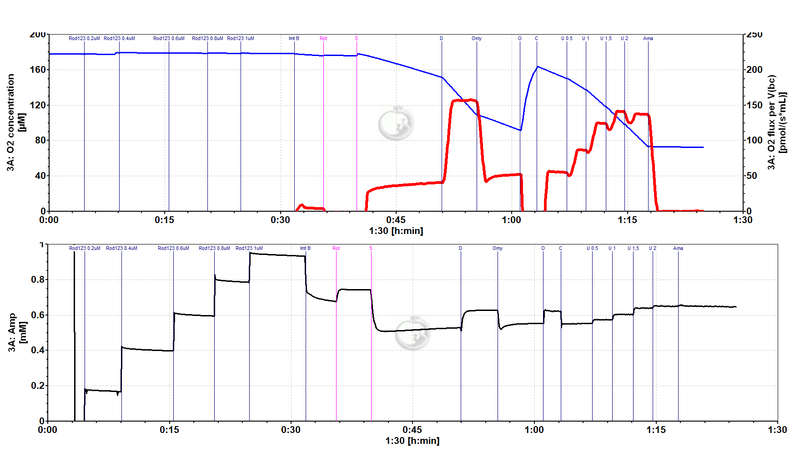From Bioblast
Description
Rhodamine 123 (Rh123) is an extrinsic fluorophore and can be used as a probe to determine changes in mitochondrial membrane potential. Rh123 is a lipophilic cation that is accumulated by mitochondria in proportion to Δψmt. Using ethanol as the solvent, the excitation maximum is 511 nm and the emission maximum is 534 nm. The recommended excitation and emission wavelengths in PBS are 488 and 515-575 nm, respectively (Sigma-Aldrich).
Abbreviation: Rh123
Application in HRR
- Rh123: Rhodamine 123 (C21H17CIN2O3); Life Technologies, R302, 25 mg, store at -20 °C, M = 380.83 g·mol-1
- Preparation of 5 mM storage solution (dissolved in ethanol)
- Weight 1.9 mg of Rh123 and dissolve in 1 mL ethanol;
- Divide into 0.1 mL aliquots (use dark vials);
- Store at -20 °C.
- Preparation of 0.2 mM stock solution
- Dilute a 100 µL aliquot 5 mM storage solution with 2400 µL ethanol to reach 2.5 mL final volume;
- Divide into 0.2 mL aliquots (use dark vials);
- Store at -20 °C.
- O2k manual titrations MiPNet09.12 O2k-Titrations
- Titration volume: in 2-µL steps using a 10 µL syringe (2 mL O2k-Chamber).
- Final concentration: 0.2-1 µM. Stepwise titration for calibration.
- Preparation of 0.2 mM stock solution
Signal and output
- Signal: The O2k-Fluo LED2-Module is operated through the Amperometric (Amp)-Channel of the O2k, with electric current (ampere [A]) as the primary signal.
- Fluo-Sensor: Smart Fluo-Sensor Blue equipped with Filter Set Saf
- Output: The focus of the output with Rh123 is on Type III: Force, mt-membrane potential.
Rhodamine 123 chemical background
- Several substances typically used in SUIT protocols may influence the fluorescence signal of Rhodamine 123 when injected into the O2k-Chamber (for instance colored substances such as cytochrome c). These chemicals should be tested for their effect in a background run without a biological sample, and the necessary corrections are applied.
Calibration of the raw fluorescence signal
- To calibrate the raw fluorescence signal expressed as [V] and convert to µM, you need to click on ´Calibration/A: or B: Amperometric, Amp´ to open Amp calibration window in DatLab.
SUITbrowser question: Mitochondrial membrane potential
- With the use of Rhodamine 123, the mitochondrial membrane potential can be assessed by O2k-Fluorometry.
- Use the SUITbrowser to find the best protocol to answer this and other research questions.
Rh123 with the O2k-FluoRespirometer: exploratory experiments
- Figure 1. Simultaneous measurement of respiration and mt-membrane potential using Rhodamine 123. Brain mitochondria isolated from mouse were fueled with succinate (S-pathway control state) in presence of rotenone to inhibit Complex I, displaying an accumulation of the dye according to their Δψmt in the LEAK state (hyperpolarization, Amp record shows a decrease). After the addition of ADP, the depolarization of Δψmt is reflected in an increase of the fluorescence. The addition of the ATP synthase inhibitor oligomycin promotes to reach again LEAK state and, as consequence, hyperpolarization of the membrane (Amp record shows a decrease of the signal). Finally, upon the addition of the uncoupler CCCP, the Δψmt collapses and the release of the Rhodamine 123 from the mitochondria is associated with an increase of fluorescence. The fluorescence signal was calibrated by Rhodamine 123 before adding the sample in a step-wise titration (max. concentration 1 µM). The optimum concentration of Rhodamine 123 to measure the membrane potential has to be tested in previous experiments.
HRR / Safranin,TMRM, Rhodamine 123
- The method is easy to use since the Fluorescence-Sensor is not in direct contact with the sample. Transformation of the fluorescence signal of safranin, or TMRM or Rhodamine 123 to mtMP [mV] requires a specific method for each preparation and protein content, which has to be kept constant in an experimental series [1].
- » More details: »Discussion«.
Troubleshooting
- Bioblast links: Force and membrane potential - >>>>>>> - Click on [Expand] or [Collapse] - >>>>>>>
- Fundamental relationships
- mt-Membrane potential and protonmotive force
- O2k-Potentiometry
- » O2k-Catalogue: O2k-TPP+ ISE-Module
- » O2k-Manual: MiPNet15.03 O2k-MultiSensor-ISE
- » TPP - O2k-Procedures: Tetraphenylphosphonium
- » Specifications: MiPNet15.08 TPP electrode
- » Poster
- » Unspecific binding of TPP+
- » TPP+ inhibitory effect
- O2k-Potentiometry
- O2k-Fluorometry
- » O2k-Catalogue: O2k-FluoRespirometer
- » O2k-Manual: MiPNet22.11 O2k-FluoRespirometer manual
- » Safranin - O2k-Procedures: MiPNet20.13 Safranin mt-membranepotential / Safranin
- » TMRM - O2k-Procedures: TMRM
- O2k-Fluorometry
- O2k-Publications
MitoPedia methods:
Fluorometry
Labels: MiParea: Respiration, Instruments;methods
HRR: Oxygraph-2k, O2k-Fluorometer, O2k-Protocol
O2k-MultiSensor
- ↑ Sumbalova Z, Gnaiger E (2015) High-resolution measurement of mitochondrial membrane potential and respiration – comparison of potentiometric and fluorometric methods. Abstract MiP2015. »Bioblast link«

